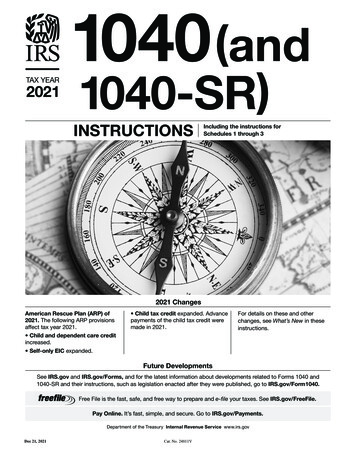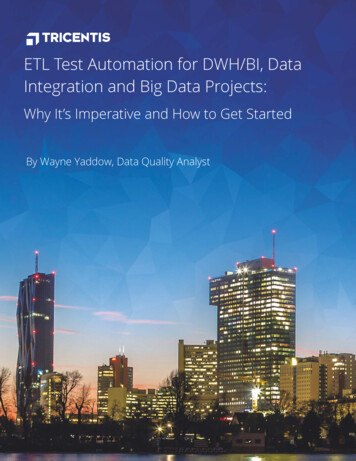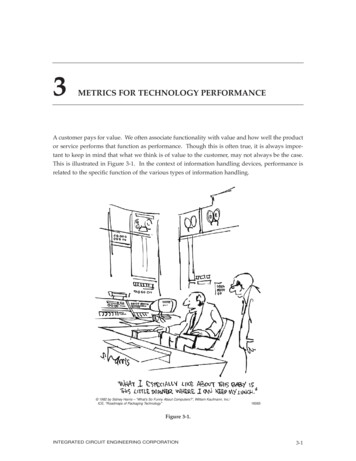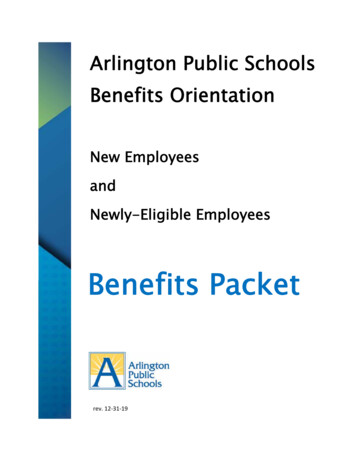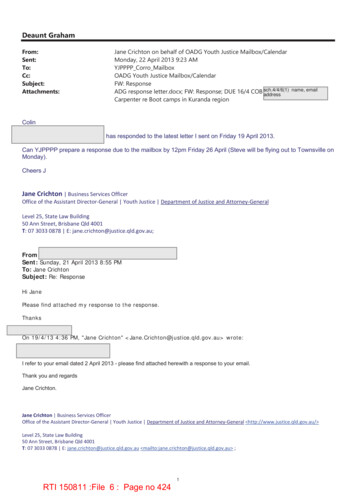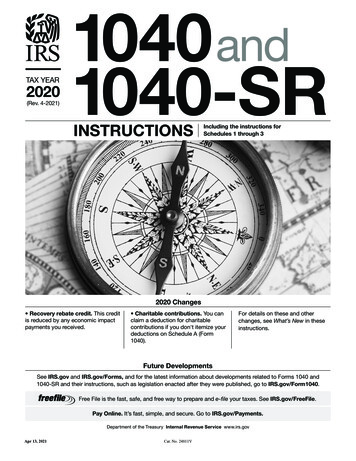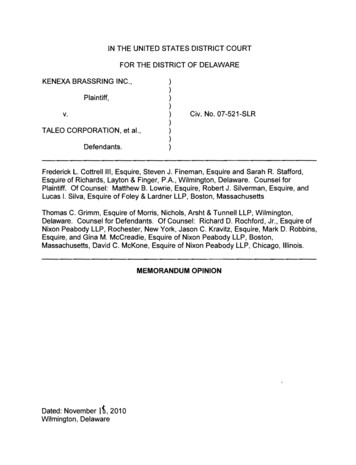
Transcription
IN THE UNITED STATES DISTRICT COURTFOR THE DISTRICT OF DELAWAREKENEXA BRASSRING INC.,Plaintiff,v.TALEO CORPORATION, et aI.,Defendants.)))))))))Civ. No. 07-521-SLRFrederick L Cottrell III, Esquire, Steven J. Fineman, Esquire and Sarah R. Stafford,Esquire of Richards, Layton & Finger, P.A., Wilmington, Delaware. Counsel forPlaintiff. Of Counsel: Matthew B. Lowrie, Esquire, Robert J. Silverman, Esquire, andLucas I. Silva, Esquire of Foley & Lardner LLP, Boston, MassachusettsThomas C. Grimm, Esquire of Morris, Nichols, Arsht & Tunnell LLP, Wilmington,Delaware. Counsel for Defendants. Of Counsel: Richard D. Rochford, Jr., Esquire ofNixon Peabody LLP, Rochester, New York, Jason C. Kravitz, Esquire, Mark D. Robbins,Esquire, and Gina M. McCreadie, Esquire of Nixon Peabody LLP, Boston,Massachusetts, David C. McKone, Esquire of Nixon Peabody LLP, Chicago, Illinois.MEMORANDUM OPINIONDated: November l , 2010Wilmington, Delaware
R 1oN,istrict JudgeI. INTRODUCTIONPlaintiff Kenexa Brassring, Inc ("plaintiff') owns two patents directed to systemsand methods for accurately entering information into a highly structured database frommultiple non-uniformly formatted data sources. On August 27, 2007, plaintiffcommenced this patent infringement action against defendants Taleo Corporation("Taleo") and Vurv Technology, Inc. ("Vurv") (collectively "defendants") alleging thatmultiple products sold by each company infringe U.S. Patent Nos. 5,999,939 ("the '939patent") and 6,996,561 ("the '561 patent"). (0.1. 1) Defendants have asserted variousaffirmative defenses and counterclaims in response to plaintiffs complaint, includingnoninfringement and invalidity of the patents in suit. (0.1. 6)The parties have proffered meanings for the disputed claim limitations and movefor summary judgment. Plaintiff seeks summary judgment of infringement, anddefendants seek summary judgment of invalidity of the patents in suit. (0.1.156; 0.1.153) The court has jurisdiction pursuant to 28 U.S.C. §§ 1331 and 1338. For thereasons that follow, the courtthe motions.II. BACKGROUNDA. The Parties and the Technology at IssueThe technology at issue concerns systems and methods for collecting andmaintaining information about job applicants. (0.1. 156 at 2) The parties provide"applicant tracking systems" that permit job applicants to submit resumes in electronicform over the internet. (Id.) Once an applicant has submitted his resume, the systemscans the resume looking for key information such as telephone number, work history,
or educational background. (Id.) Once this information is identified, it is extracted andpresented to the applicant for verification. (Id. at 2-3) During this time, the applicantmay be asked to submit supplemental information that was not collected by the resumeprocessing. (/d. at 3) After the applicant verifies that the extracted information iscorrect and responds to the supplemental inquiries, the information is stored in astructured database. (Id. at 2) It is through this verification that the systems ensure theaccuracy of the information contained in the database.Defendants Taleo and Vurv both sell products that compete with plaintiff'sapplicant tracking systems. (/d. at 3) During the pendency of this case, Taleo acquiredVurv, and this combined entity has emerged as the market leader. (/d.)B. The Patents in Suit1. The '939 patentThe '939 patent is directed to a system and method for accurately enteringinformation into a highly structured database from multiple non-uniformly formatted datasources by allowing the user to interactively modify data extracted by the algorithmbefore said data is stored in the database. ('939 patent, abstract) The '939 patentissued on December 7, 1999 and claims priority to a provisional application filed onDecember 21, 1997. Plaintiff alleges that defendants' products infringe every claim ofthe '939 patent. (D.I. 156 at 10)The patent contains twenty claims, three of which are independent. Independentclaim 1 is illustrative:A method for facilitating the accurate transfer of information fromeach of a plurality of nonuniformly formatted source data streams into a2
structured database, said method comprising the steps of:supplying digital data representing each of a plurality of sourcedata streams from a plurality of users, each said source datastream containing data corresponding to multiple discerniblesource data strings;processing said digital data for extracting selected ones of saidsource data strings and generating related target datastrings;displaying a structured form comprised of multiple fields, each fieldbeing capable of accommodating a data string and whereinone or more of said fields have said target data stringsinserted within;enabling each user to modify and/or accept said target data stringsinserted within said displayed form corresponding to saidsource data stream originating from said user; andstoring data corresponding to said data strings from said form fieldsinto a database.('939 patent, col. 6:35-55)The remaining independent claims slightly alter claim 1 by claiming "a system forfacilitating" instead of "a method for facilitating."2. The '561 patentThe '561 patent is a continuation of an abandoned application which was, in turn,a continuation-in-part of the '939 patent. The '561 patent issued February 7, 2006.The '561 and '939 patents are so similar that the '561 patent is subject to a terminaldisclaimer; its abstract is a mirror of the '939's abstract. The '561 patent contains 36claims, five of which are independent. Plaintiff alleges that Taleo's products infringeclaims 1-3, 5-16, and 18-36 of the '561 patent, and that Vurv's products infringe themall. (0.1. 156 at 10)Independent claim 1 is illustrative of the asserted claims, and reads as follows:A method for facilitating the accurate transfer of information into astructured database, said method comprising the steps of:receiving digital data from one or more users representing one or3
more nonuniformly formatted source data streams, each saidsource data stream containing digital data corresponding toone or more discernable source data strings, wherein saiddigital data includes first digital data that is personalinformation about a first user;extracting selected ones of said source data strings from said sourcedata streams and generating related target data strings;sending a structured form to said first user comprised of multiplefields, each field being capable of accommodating a data stringand wherein any said generated target data strings areinserted;enabling said first user to modify and/or accept said target datastrings inserted within said structured form;receiving digital data from said first user corresponding to said targetdata strings from said structured form fields; andstoring said digital data corresponding to said target data strings fromsaid structured form fields in said database.('561 patent, col. 8:45-9:3) As with the '939 patent, subsequent independent claimsslightly alter claim 1 by claiming u a system for facilitating," instead of "a method forfacilitating." (See, e.g., '561 patent, col. 9:21-45)Other independent claims require the "data stream" to be a digital representationof a resume. Independent claim 21 highlights this change:A method for facilitating the accurate transfer of resume informationfrom a non uniformly formatted source data stream to a structured database,said method comprising the steps of:receiving a digital representation of a resume from a first jobapplicant;extracting data strings from said digital representation and generatingrelated target data strings;sending at least a portion of said target data strings to said first jobapplicant; andenabling said first job applicant to modify said target data strings tocreate modified data strings;receiving said modified data strings from said first job applicant; andstoring said modified data strings in the database.('561 patent, col. 10:48-63)c.The Accused Products4
1. VurvVS.TaleoThe accused products sold by defendants fall into two general groups: (1) thosecreated by Taleo, e.g., Taleo's "Enterprise Edition," "Business Edition," and "EdgeEdition;" and (2) those created by Vurv, e.g., Vurv's "Corporate Edition," "StaffingEdition," and "Express." It is undisputed that the two groups of products function with atleast one major difference: the Taleo products include a hyperlink that shows the userhis or her original resume when clicked on, whereas the Vurv products include theuser's original resume in a text box below where the fields containing the extractedstrings are displayed. (D.1. 193 at 41:15-42:10)2. Differentiation of products within the Vurv and Taleo product linesThe parties disagree as to whether plaintiff has shown that the products withinthe Taleo and Vurv lines operate in the same manner, Le., do Taleo's "EnterpriseEdition," "Business Edition," and "Edge Edition" all operate in the same manner forpurposes of this suit, and do Vurv's "Corporate Edition," "Staffing Edition," and"Express" also function in the same way? Plaintiff claims that, in response to itscontention interrogatories and questions to 30(b)(6) designees, defendants did notidentify any manner in which the products operate differently. (D.1. 179 at 2-3)Defendants stress that plaintiff has the burden to demonstrate equivalent functionality.(D.1. 170 at 6-8) Plaintiff argues that defendants should be estopped from making thisargument in view of their interrogatory and 30(b )(6) designee responses. (D .1. 179 at 23)Specifically, plaintiffs interrogatory 10 asked:5
Foreach Resume Product identified in the answer to Interrogatory 2, and foreach claim of each of the patents-in-suit, identify any claim limitation thatVurv contends is not met, and for such limitation (i) state Vurvs interpretationof the claim limitation, (ii) explain why the limitation is not met literally, (iii)explain why the limitation is not met by equivalents, and (iv) identify any andall facts, evidence, and documents in support of Vurv's contention.(0.1. 160, ex. 7 at 1-2) (emphasis added)Defendants objected to the interrogatory, then proceeded to list multiple claimlimitations, referring to the "Resume Products" collectively.1 Defendants never identifiedhow an individual product worked, nor explained how any product functioned differently'from any other product. (Id. at 2-19) There were multiple occasions when defendantsanswered that the products' functionality varied "in some instances," yet they did notspecify whether the products' functionality varied from product to product, or whethertheir output varied in the same manner based on user input.When questioned about the resume submission portion of Taleo's products,Taleo's 30(b)(6) designee 2 participated in the following dialogue:Q: [Is] there[] something that is lurking in the back of your mind about howthese two systems operate, just in terms of the resume submission portionof it? A: Not really, unless we come into extremely technical detail, youknow. I mean so far we haven't gone into these details so I don't see what1 For example, in response to the "means for generating a structured formcomprised of multiple fields, each field capable of accommodating a data string andwherein any said generated target data strings are inserted" limitation of claim 7 of the'561 patent, defendants stated that "[t]he Resume Products, in some instances, send aform to the user that includes multiple fields. Some of the fields are not capable ofaccommodating a string." (ld. at 5) Defendants did not specify which products sent aform to the user that includes multiple fields, nor did they specify under whatcircumstances the products would not send the form.2 Taleo had multiple 30(b)(6) deSignees. The cited reference is to the testimonyof Mr. Zenadocchio, Taleo's 30(b)(6) designee for technical testimony with respect tohow the Taleo products work. (0.1. 160, ex. 4 at 5:9-15)6
kind of differences that I could talk about.(0.1. 160, ex. 4 at 8:23-9:8) During his deposition, Vurv's designee was asked a similarquestion about the Vurv products' "resume uploading feature," and gave a similarresponse. (0.1. 160, ex. 3 at 62:11-13) ("Q: I mean, as you are sitting here today youcan't think of anything that distinguishes [Vurv's products]? A: No, I can't think ofanything.")III. STANDARD OF REVIEWA court shall grant summary judgment only if "the pleadings, depositions,answers to interrogatories, and admissions on file, together with the affidavits, if any,show that there is no genuine issue as to any material fact and that the moving party isentitled to judgment as a matter of law." Fed. R. Civ. P. 56(c). The moving party bearsthe burden of proving that no genuine issue of material fact exists. See MatsushitaElec.lndus. Co. v. Zenith Radio Corp., 475 U.S. 574, 586 n.10 (1986). "Facts thatcould alter the outcome are 'material,' and disputes are 'genuine' if evidence exists fromwhich a rational person could conclude that the position of the person with the burdenof proof on the disputed issue is correct." Horowitz v. Fed. Kemper Life Assurance Co.,57 F.3d 300, 302 n.1 (3d Cir. 1995) (internal citations omitted). If the moving party hasdemonstrated an absence of material fact, the nonmoving party then "must comeforward with 'specific facts showing that there is a genuine issue for trial. '" Matsushita,475 U.S. at 587 (quoting Fed. R. Civ. P. 56(e)). The court will "view the underlying factsand all reasonable inferences therefrom in the light most favorable to the partyopposing the motion." Pa. Coal Ass'n v. Babbitt, 63 F.3d 231, 236 (3d Cir. 1995). The7
mere existence of some evidence in support of the nonmoving party, however, will notbe sufficient for denial of a motion for summary judgment; there must be enoughevidence to enable a jury reasonably to find for the nonmoving party on that issue. SeeAnderson v. Liberly Lobby, Inc., 477 U.S. 242, 249 (1986). If the nonmoving party failsto make a sufficient showing on an essential element of its case with respect to which ithas the burden of proof, the moving party is entitled to judgment as a matter of law.See Celotex Corp. v. Catrett, 477 U.S. 317, 322 (1986).IV. DISCUSSIONA. Infringement1. StandardA patent is infringed when a person "without authority makes, uses or sells anypatented invention, within the United States . during the term of the patent." 35U.S.C. § 271 (a). A two-step analysis is employed in making an infringementdetermination. Markman v. Westview Instruments, Inc., 52 F.3d 967,976 (Fed. Cir.1995). First, the court must construe the asserted claims to ascertain their meaningand scope. Id. Construction of the claims is a question of law subject to de novoreview. See Cybor Corp. v. FAS Techs., 138 F.3d 1448, 1454 (Fed. Cir. 1998). Thetrier of fact must then compare the properly construed claims with the accusedinfringing product. Markman, 52 F.3d at 976. This second step is a question of fact.See Bai v. L & L Wings, Inc., 160 F.3d 1350, 1353 (Fed. Cir. 1998)."Direct infringement requires a party to perform or use each and every step orelement of a claimed method or product." BMC Res., Inc. v. Paymentech, L.P., 4988
F.3d 1373, 1378 (Fed. Gir. 2007). "If any claim limitation is absent from the accuseddevice, there is no literal infringement as a matter of law." Bayer AG v. Elan Pharm.Research Corp., 212 F.3d 1241,1247 (Fed. Gir. 2000). Ifan accused product does notinfringe an independent claim, it also does not infringe any claim depending thereon.See Wahpeton Canvas Co. v. Frontier, Inc., 870 F.2d 1546, 1553 (Fed. Gir. 1989). Thepatent owner has the burden of proving infringement and must meet its burden by apreponderance of the evidence. Smith Kline Diagnostics, Inc. v. Helena Lab. Corp., 859F.2d 878, 889 (Fed. Gir. 1988) (citations omitted).2. Differentiation of defendants' productsAs discussed above, defendants claim that plaintiff has failed to prove that theirproducts function in the same manner for purposes of infringement. Plaintiff respondedthat defendants had admitted their products worked the same in their response tocontention interrogatories and by their 30(b)(6) designees. In their argument,defendants do not explain their limited responses to contention interrogatories, nor dothey attempt to distinguish the cited testimony of Taleo's 30(b)(6) designee. However,despite the similarity in testimony, defendants argue that Vurv's 30(b)(6) designee wasonly talking about the '''resume uploading feature,' which says nothing about any of thenumerous other limitations of the claims of the patents in suit." (0.1. 170 at 7) Thisargument is unpersuasive. Defendants appear to imply that the "resume uploadfeature" is limited to the user sending a digital copy of his resume to the server andnothing more. This is not true. For purposes of this lawsuit, the only relevantfunctionality of defendants' products is that functionality which handles the user's9
resume from the point the user transmits the raw, unformatted version to a server, untilthe parsed data strings are stored in a database. This is the resume uploading featureof the accused products. Any other functionality is irrelevant.Defendants' designees knew or should have known what plaintiff's attorneysmeant by the "resume upload feature." The Vurv designee had spent the prior 32pages of deposition testimony describing the old system of uploading and parsing aresume that involved the use of a scanner, optical character recognition software, andan employee to extract the data and put it into the appropriate database fields. (0.1.160, ex. 3 at 11-43) The designee was then shown a series of screen shots ofdefendants' product that plaintiff's lawyer called "the resume uploading feature." (Id. at61:23-62:16) When the Vurv designee was questioned as to which product it was, hecould not tell if the product in the screen shot was the corporate or the staffing product.(Id. at 61 :5-22) The designee then proceeded to explain how the system generallyworked, beyond merely transmitting a resume to a server, without enumerating anypoint of differentiation between the potential products. (Id. at 62:22-102:25)Given plaintiff's questions and defendants' responses, the court finds thatplaintiff has met its burden of proving that defendants' products function the same wayfor purposes of patent infringement within their respective product lines. This is not acase where plaintiff failed to ask the defendant questions, and is baldly asserting thatthe products in question are homogeneous without any form of proof. Here,interrogatory number 10 specifically asked defendants why each product did notinfringe the patents in suit, yet both defendants responded in the same manner for all.10
Plaintiff specifically asked both defendants' 30(b)(6) designees if the resume uploadingfeature was the same across the product line, and both designees answered that itwas. For the Vurv designee especially, this answer came not in a vacuum, but in thecontext of discussing how the previous generation of products worked from resumetransmission to processing by an employee. After admitting that he could not identifywhich product was shown in plaintiff's screen shots, the designee explained how theproducts worked without differentiating any differences between them. Defendantscannot group their products together when asked whether they differ, then turn aroundand claim that plaintiff has failed to meet its burden of showing that they operate in thesame way.3. Claim limitationsPlaintiff moves for summary judgment that the Vurv products infringe eachasserted claim of the patents in suit. Plaintiff also moves for summary judgment thatthe Taleo products infringe claims 1-3, 5-16, and 18-36 of the '561 patent and eachclaim of the '939 patent. (D.I. 156 at 10) Defendants allege that plaintiff has notestablished that the accused products meet the limitations of the claims that are notsu
Taleo The accused products sold by defendants fall into two general groups: (1) those created by Taleo, e.g., Taleo's "Enterprise Edition," "Business Edition," and "Edge Edition;" and (2) those created by Vurv, e.g., Vurv's "Corporate Edition," "Staffing Edition," and "Express." It is un

